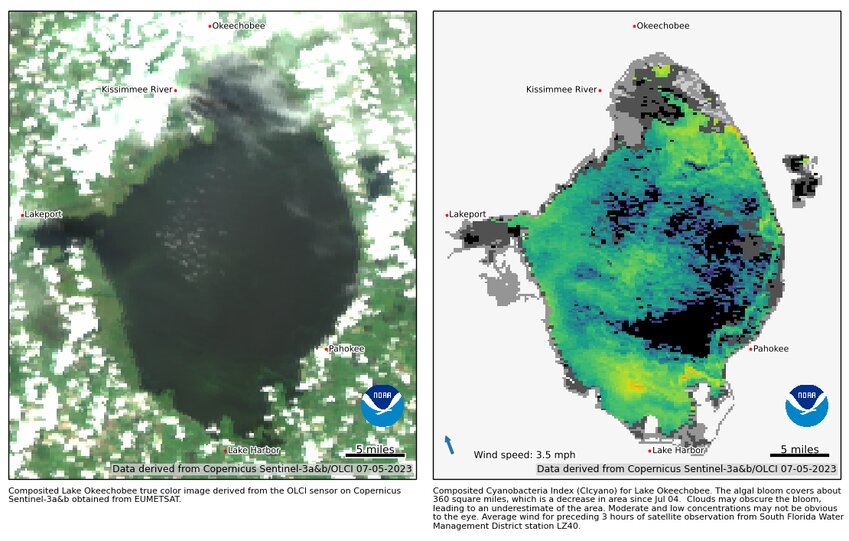A dramatic decrease in algal blooms is indicated on the July 6 satellite image of Lake Okeechobee by NOAA.
The July 6 image …
Join our family of readers for as little as $5 per month and support local, unbiased journalism.
Already have an account? Log in to continue. Otherwise, follow the link below to join.

To Our Valued Readers –
Visitors to our website will be limited to five stories per month unless they opt to subscribe.
For $5, less than 17 cents a day, subscribers will receive unlimited access to SouthCentralFloridaLife.com, including exclusive content from our newsroom.
Our commitment to balanced, fair reporting and local coverage provides insight and perspective not found anywhere else.
Your financial commitment will help to preserve the kind of honest journalism produced by our reporters and editors. We trust you agree that independent journalism is an essential component of our democracy.
Please click here to subscribe.
Sincerely,
Katrina Elsken, Editor-in-Chief, Independent Newsmedia

Please log in to continueNeed an account?
Get every story for $5 a month. You can cancel at anytime. Print subscribersNeed to set up your free e-Newspaper all-access account? click here. Register for an accountYou'll need an account on our site to post calendar listings and comment on stories. Sign up today. It's free, and takes just a minute! |
A dramatic decrease in algal blooms was indicated on the July 6 satellite image of Lake Okeechobee by the National Oceanographic and Atmospheric Administration (NOAA).


The July 6 image showed a area of about 60 square miles with algal bloom potential. Just a day before, the July 5 NOAA image indicated algal bloom coverage of 360 square miles.
It’s not unusual for algal blooms on the big lake to change quickly.
What causes an algal bloom die off? Cloudy days, wind and rain can cause algae to die off. A large bloom may also die off after consuming the available nitrogen in the water.
This summer, the South Florida Water Management District and Florida Department of Environmental Protection have been treating small areas with dense blooms – mostly in canals, marinas or water control structures – with algaecide. A pelleted form of hydrogen peroxide is used to dissipate the bloom.
Cyanobacteria (commonly called blue-green algae) are microscopic organisms found in all freshwater lakes, ponds, river and streams. When they reproduce rapidly into concentrations sufficient to be visible to the human eye, it is referred to as a “bloom.” To reproduce rapidly into a bloom, cyanobacteria need hot weather, nitrogen, phosphorus, sunlight and little water movement.
Cloudy weather, which deprives the cyanobacteria of sunlight, can cause a die-off. Some cyanobacteria (like Anabaena) are “nitrogen fixers” and can use nitrogen from the air. Others – like Microcystis aeruginosa, which has been most common on Lake O this summer – depend on nitrogen available in the water. If a dominant cyanobacteria that is not a “nitrogen fixer” uses up the available nitrogen in the water, this can cause the bloom to die. When that happens, if there is still sufficient phosphorus in the water, a nitrogen-fixer cyanobacteria may become dominant and create a new bloom.
The NOAA images are derived from Copernicus Sentinel-3 satellite data from the European Organization for the Exploitation of Meteorological Satellites (EUMETSAT) and are processed by NOAA’s National Centers for Coastal Ocean Science. The NOAA computer program uses the data collected by the satellite images to postulate the potential for algal blooms.
The satellite images are a snapshot of Lake Okeechobee at a moment in time on a given day. Fishermen have noted that an area shown in red on the map, indicating high potential for an algal bloom, may not have any visible algae at all. Cyanobacteria cannot move on their own. They are pushed by wind and carried by water flow. Cyanobaterica can rise and fall in the water by inflating and deflating gas vesicles.
The FDEP website explains: “Response efforts are currently underway to treat blue-green algal blooms at water control structures and public access points on Lake Okeechobee and within the C-43 (Caloosahatchee River) and C-44 (St. Lucie) canals. The Florida Department of Environmental Protection in partnership with the South Florida Water Management District and the U.S. Army Corps of Engineers have deployed an innovative technology to target blue-green algal cells and the toxins they produce. In large systems like Lake Okeechobee, treatments may need to be repeated over the course of the bloom season as untreated bloom waters may migrate into treated areas due to winds and currents. Stringent water quality monitoring is ongoing by the contractor and SFWMD while this technology is deployed. All sampling locations and results are posted to DEP’s Algal Bloom Monitoring and Response dashboard.”
The FDEP Algae Bloom dashboard is online at https://floridadep.gov/AlgalBloom.
The NOAA satellite images are online at: coastalscience.noaa.gov.
